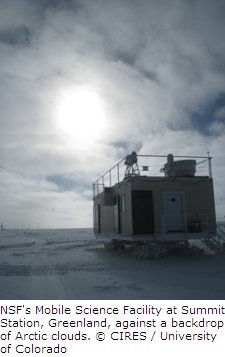 Source: NOAA
Source: NOAA
Authors: Bennartz, et al.
Topic Area: Clouds, Ice Sheets, Ice Melt
Geographic Area: Greenland
Clouds over the central Greenland Ice Sheet last July were “just right” for driving surface temperatures there above the melting point, according to a new study by scientists at National Oceanic and Atmospheric Administration (NOAA) and the Universities of Wisconsin, Idaho and Colorado. The study, published on April 3 in Nature, found that thin, low-lying clouds allowed the sun’s energy to pass through and warm the surface of the ice, while at the same time trapping heat near the surface of the ice cap. This combination played a significant role in last summer’s record-breaking melt.
“Thicker cloud conditions would not have led to the same amount of surface warming,” said Matthew Shupe, Research Meteorologist with NOAA’s Cooperative Institute for Research in Environmental Sciences at the University of Colorado and the NOAA Earth System Research Laboratory. “To understand the region’s future, you’ll need to understand its clouds. Our finding has implications for the fate of ice throughout the Arctic.”
Scientists around the world are trying to understand how quickly Greenland is warming because ice melt there contributes to sea level rise globally. The Greenland Ice Sheet is second only to Antarctica in ice volume. In July, more than 97 percent of the Greenland Ice Sheet surface experienced some degree of melting, including at the National Science Foundation’s (NSF) Summit Station, high atop the ice sheet. According to ice core records, the last time the surface at Summit experienced any degree of melting was in 1889, but it is not known whether this extended across the entire ice sheet.
To investigate whether clouds contributed to, or counteracted, the surface warming that melted the ice, the authors modelled the near-surface conditions. The model was based on observations from a suite of sophisticated atmospheric sensors operated as part of a study called the Integrated Characterization of Energy, Clouds, Atmospheric State and Precipitation at Summit.
“The July 2012 ice melt was triggered by an influx of unusually warm air sweeping in from North America, but that was only one factor,” said David Turner, Research Meteorologist with the NOAA National Severe Storms Laboratory and one of the lead investigators. “In our paper, we show that low-lying clouds containing a low amount of condensed water were instrumental in pushing surface air temperatures up above freezing and causing the surface ice to melt.”
Clouds can cool the surface by reflecting solar energy back into space, and can warm it by radiating heat energy back down to the surface. The balance of those two processes depends on many factors, including wind speed, turbulence, humidity and cloud “thickness”, or liquid water content.
In certain conditions, these clouds can be thin enough to allow some solar radiation to pass through, while still “trapping” infrared radiation at ground level. That is exactly what happened last July: the clouds were just right for maximum surface warming. Thicker clouds would have reflected away more solar radiation; thinner ones couldn’t have trapped as much heat, and in either of those cases, there would have been less surface warming.
The researchers also found these thin, low-lying liquid clouds occur 30 to 50 percent of the time in summer, both over Greenland and across the Arctic. Current climate models tend to underestimate their occurrence in the Arctic, which limits those models’ ability to predict how clouds and their warming or cooling effects may respond to climate change.
“The cloud properties and atmospheric processes observed with the Summit Station instrument array provide a unique dataset to answer the large range of scientific questions we want to address,” said Turner. “Clouds play a big role in the surface mass and energy budgets over the Greenland Ice Sheet. Melting of the world’s major ice sheets can significantly impact human and environmental conditions via its contribution to sea level rise.”
Better understanding of clouds also improves climate models.
“Our results may help to explain some of the difficulties that current global climate models have in simulating the Arctic surface energy budget, including the contributions of clouds,” said Ralf Bennartz, lead author for the study and professor at the University of Wisconsin-Madison. “Above all, this study highlights the importance of continuous and detailed ground-based observations over the Greenland Ice Sheet and elsewhere. Only such detailed observations will lead to a better understanding of the processes that drive Arctic climate.”
Click here to read/download the Full Study – “July 2012 Greenland Melt Extent Enhanced by Low-Level Liquid Clouds”.
Source: NOAA.

















